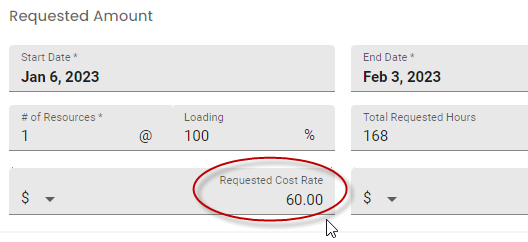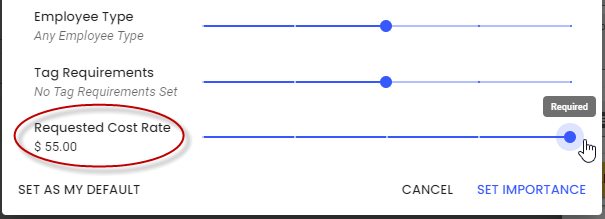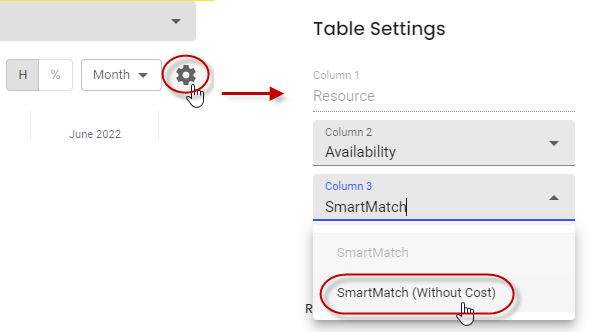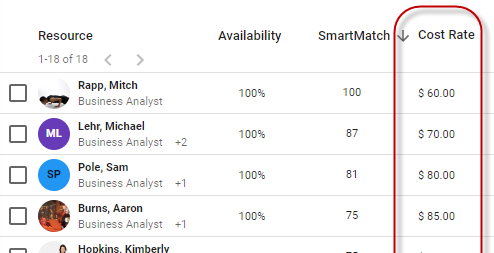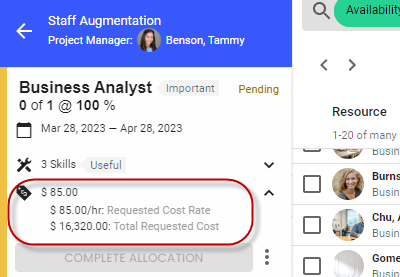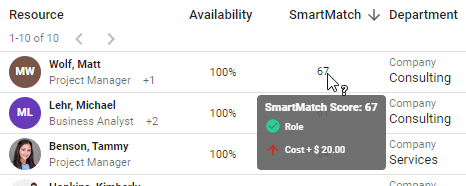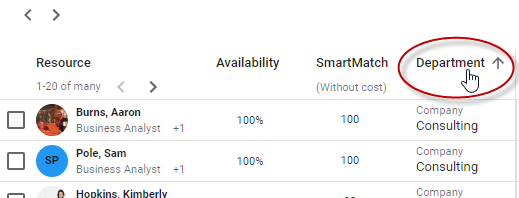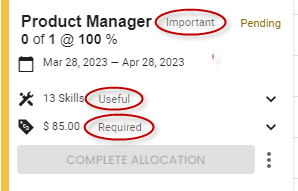New feature: Cost optimized resource allocation
In April 2023, we’ll be adding cost optimization features to resourcing in Polaris.
These features should help project managers better control the costs of resources allocated to their projects, and better understand how each resource impacts their bottom line.
Plus, these changes should help resource managers more accurately meet PM cost expectations when allocating resources.
All of the cost-related functionality mentioned in this post is only available to project managers and resource managers who’ve been assigned these permissions:
- Cost Data:
- Hourly Cost:
Changes for project managers
We’re moving and renaming the Cost Rate field in resource requests
Currently, when requesting a resource, when you select a role, a Cost Rate field will appear beside the Role field, displaying the selected role’s cost rate.
After this upgrade, the Cost Rate field will be:
- Renamed Requested Cost Rate, to make it more obvious that this is a requested rate, not necessarily the rate for the resource that will be allocated.
- Available even if no role is selected, meaning project managers can now include a cost rate in their requests even if they’re not requesting a specific role, and will have an easier time finding low-cost resources.
The Total Requested Cost for the request will automatically update to use the new rate as you edit this field.
We’re renaming the Requested Cost field and making it editable
Currently, the Requested Cost field displays a read-only value calculated based on resource cost rate and allocation duration.
After this upgrade, we’ll be renaming that field Total Requested Cost, and managers will be able to edit that value. Updating the total cost will automatically update the requested cost rate.
This change makes it easier for project managers to find resources that fit their remaining budget or billing requirements.
If you add or change the role requirement, the requested cost rate and total requested cost will always update to the selected role’s default rate. So, always be careful to ensure cost values are correct before submitting the request.
Project managers will be able to specify the importance of the Requested Cost Rate
You can currently set an importance level for requirements like role, skill, or group. After this change, you’ll also be able to set an importance rating for the requested cost rate, which will impact how heavily SmartMatch weighs the importance of cost rates during allocation.
We’ve also renamed the Importance button to Set Importance, and we’ve changed its formatting.
Changes for resource managers
SmartMatch will consider cost rates by default
By default, SmartMatch will factor in cost requirements when returning suggestions, if they’ve been included in the request.
If you don’t want cost considered, you can click the Switch to SmartMatch without cost link located under the results.
Or, click the gear icon and update the SmartMatch option to exclude cost.
Resource managers without cost data permission will only see one option: SmartMatch, excluding cost.
Resource cost rates will display in SmartMatch
A Cost Rate column will be available on the SmartMatch allocation page that will show each resource’s rate and will help managers find lower-cost matches. This column displays whether or not you’ve included cost as a factor in the match.
Requested cost will display while allocating
You’ll be able to view the cost criteria the project manager requested, in the left request details column when allocating resources.
This will help resource managers better meet project manager requests.
You’ll also be able to see how each resource deviates from the requested role and cost rate, by hovering over their SmartMatch score.
Other related changes
Three configurable criteria columns will be available when allocating
On the SmartMatch allocation page, you’ll be able to switch the default Cost Rate column to use a different parameter that’s more relevant to that allocation, like Department or Employee Type.
To do this, you’ll click the gear icon. Several alternate parameters will be available, and you’ll be able to sort the SmartMatch results by these column values.
You’ll also be able to switch the Availability column. But, if you leave then return to the SmartMatch allocation page, results will once again be ranked by availability and SmartMatch score, since those criteria result in the best matches.
We’ll be improving how request criteria display in left side panel
The importance rating the project manager selected for each request criterion, like skill or role, will display in the left side menu.
Also, filter icons will always be available for each request criterion (skill, department, etc) displayed in the side panel. These can be used to filter the SmartMatch results to show only resources with that skill.


